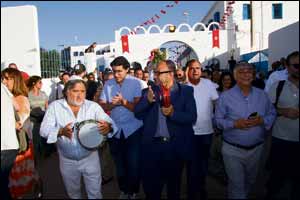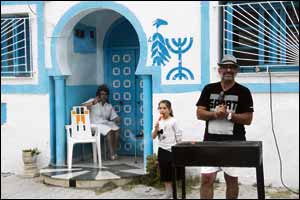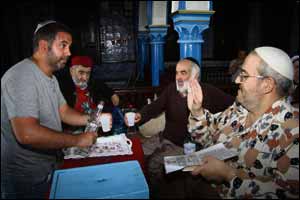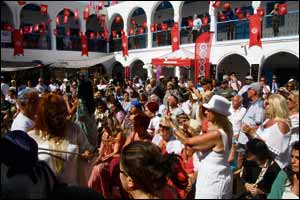 | ||||
| That special relationship between Jews and Muslims there for all to see in Tunisia | ||||
THOUSANDS of mainly Jewish expats descended on the Tunisian island of Djerba this week for the annual Lag b’Omer pilgrimage.
As always, the numbers were swelled by visitors of all faiths, fascinated by the unique relationship between Muslims and Jews that has existed for centuries, if not millennia, depending upon which version of early Jewish settlement in Tunis is to be accepted. Legend has it that Jews arrived on Djerba more than 2,500 years ago when the first temple was destroyed in Jerusalem, but the first concrete evidence is an 11th century reference in the Cairo Geniza. It is even suggested that the Kohanim brought with them a door and stones from the temple which they incorporated into the Ghriba synagogue, Local tradition says that the shul was erected where a young girl, ghriba (‘the isolated one’) had lived. She was said to be something of an outcast and her body was discovered by Jews in a nearby village. She was buried in a cave that became the site of the Ghriba pilgrimage. It is unique in world Jewry and during its heyday in the 1980s attracted as many as 12,000 participants. This year, up to 5,000 took part, but at one point in the 1990s figures had dropped to below 1,000 and one year it was cancelled altogether amid safety fears. An attack in 1985 by a policeman who was guarding the event saw him open fire on the crowd, killing three and wounding 15. And, in April 2002, al-Qaeda claimed responsibility for a lorry bomb that killed 21 people. But that is no reflection on relations between indigenous Jews and Muslims. One Jewish leader said: “We live together, We visit our friends on their religious holidays. We work together. “Muslims buy meat from our butchers. when we are forbidden to work or cook on Shabbat, we buy bread and kosher food cooked by Muslims and our children play together”. This week, for the first time in 32 years, the Ghriba coincided with Ramadan, which meant Muslims who were involved with the festival’s organisation endured the additional burden of fasting during daylight hours. There was a shared outdoor iftar on Wednesday evening adjacent to the synagogue at which Muslims broke their fast and Jews celebrated the end of the Ghriba. This year’s festival was masterminded by Jewish Djerban-born minister of tourism, Rene Trabelsi whose father, Perez, a familiar face within the community, has been for decades one of its mainstays.
Certainly, the Tunisian authorities went to every effort, as usual, to ensure the security of participants who came from throughout Europe, particularly France, and Israel. Extra police were drafted in and there were countless roadblocks and at the Ghriba itself, heavily armoured vehicles, tanks and armed police, many occupying positions on rooftops. Among participants was Rabbi Israel Elia, of London’s Lauderdale Road Synagogue, who left Djerba in 1971 but returns to his roots every few years. He arranged for a donation of Hebraica for the island’s Essouaini Jewish boys’ school, which was firebombed in January last year. He told me: “It is important for me to keep in touch with the community and see if I can be of help.” Tunisian Jewry, which numbered 100,000 in 1948, has shrunk to around 1,500, the majority of whom live in Djerba. Rabbi Elia was “shocked and horrified” this week to discover that the island’s Jewish cemetery is in “completed disarray” and covered in weeds. Members of his own family, including his grandfather, are buried there and, he says, its renovation as his next project. He has already secured the assistance of a benefactor from London and says: “Next year, we will see it nicely kept.” Of the Ghriba, he said: “We are witnessing something quite wonderful to see the co-existence and how this place spreads its magic, not just on locals but beyond. “Look how gorgeous it is to celebrate together in harmony.” Moshe Lewin, vice-president of the Conference of European Rabbis, told visitors this week how the pilot of the plane flying him to Tunisia, had invited him into the cockpit to show him a picture of himself at the Ghriba which he regularly attends. Tunisian Prime Minister Youssef Chahed said the Ghriba was “testimony to the openness of Tunisian people to tolerance of all beliefs”. He added that the way Djerbans of all religions lived together was an example to be followed worldwide.
Some 300 Israelis, all of Tunisian extraction, were granted special visas which allowed them, to stay in the country for up to three months, despite not having diplomatic relations with the Jewish state. A highly-emotional Dror Zion, 68, was returning to Djerba for the first time since he left 65 years ago, while Marilyn Lombert and Jacqueline Shimshon, who were born in Tunis, were witnessing the Ghriba for the first time. “We came here to make a wish,” they said, “and to see people we haven’t seen for a long time.” Like hundreds of other participants, they wrote their wishes on an egg which they placed in the bowels of the Ghriba Synagogue, accessed through a small hole in its eastern wall. By mid-afternoon, the serious business of the Ghriba begins — the auctioning of the right to lead the traditional procession between the two old Jewish towns of Hara Kabira (the big quarter) and Hara Saghira (the small quarter). The auction is held in the courtyard of the Ghriba’s very basic pilgrim accommodation, which is still used today. It is packed, with many seated on wooden benches as the sun beats down and loud Tunisian music precedes the event. The caravanserai includes traditional kosher food stalls, serving, among other fare, what is reputed to be the best bric in town — essentially a deep fried pancake with a runny egg inside. The auctioneer, invariably fuelled with copious amounts of Boukha, the local, potent liqueur distilled from dates, starts the bidding for scarves which are tied on the menara, a sort of ark on wheels, which at one time housed a Sefer Torah. The highest bidder wins the right to lead the procession and the auctioneer can be heard intoning: “Cent dinars, quatre cent dinars etc”, reaching some incredibly high figures. The proceeds help towards the maintenance of the synagogue. In a nod to modern technology, some bids arrive by mobile phone. These days, apparently for security reasons, the procession no longer completes the several kilometres walk, turning back to the Ghriba after just over half a mile. This year, it was noticeable that fewer of the expat women wore colourful, traditionals dresses, most settling for headscarves. In Djerba for the first time were 10 Muslim university students from Tunis who, as part of their doctorate courses concentrating on gender studies, history and patrimony, are looking in-depth at the Jews of Tunisia. It was maths professor Khalifa Tazaghdanti who conceived the idea after attending the Ghriba in 2016 and seeing the close relationship between Jews and Muslims. He said: “We can all be friends, eating and drinking together. Seeing the Pope visit the Emirates gave me the inspiration. “I thought, ‘why not here, where we have three religions?’” Ahlam Hajasi is completing a PhD on Tunisian Jews living in Israel and their memories of their birth country. Because she can’t visit the Jewish state, her research is conducted via Facebook and other social media. She gained her master’s degree with a plan for a Jewish museum at Hafisa, in Tunis, which has thus far been rejected by the government. Asma Rafraf is studying the costumes Jews wore in the 19th and 20th centuries and how people could be identified by their garb.
She is also interested in items of jewellery. Prof Tazaghdanti said: “It has become a necessity to show we are a democratic, diverse country, respecting religious beliefs. “The Ghriba is not enough. We need something substantial like a museum in Tunis, not in Djerba. In Djerba, we already have the Ghriba.” Meanwhile, the Jews of Djerba continue to live their traditional lifestyle. In the capital, Houmt Soukh, any number of Jewish artisan jewellers can be found selling anything from pointers for Sifrei Torah and mezzuzot to trinkets and larger items of tableware, mostly in solid silver. The skills are still passed from father to son, like Simon and Avishai Bittan who run their eponymous shop, identifiable by a large mezzuza. The island itself is till steeped in tradition with its blue doors, whitewashed buildings and menzels (houses with dome-shaped roofs). You will still find butcher shops displaying cows’ heads outside and clusters of sheep’s heads, a local delicacy. The fish market offers a huge variety of kosher species and the adjacent vegetable market has plenty of fresh produce. Nearby restaurants willingly cook fish purchased by diners at the market. Basket weaving is a dying art, and Mohamed Khacha believes he is the only Djerban remaining who can still use palm leaves for the process. My late mother, on her first visit to Djerba, had arrived late at night on the island and did not appreciate its beauty until she awoke the following morning and peered out of her window to see endless acres of palm trees. “This is paradise,” she exclaimed. More than 1,000 years ago the Greek author Homer had realised that, too, relating how Ulysses, fleeing from the siren’s haunting song, encountered a beautiful island where delicate fruit grew: the home of the Lotus Eaters. * Further information from discovertunisia.uk/contact-us * Tunisair has regular flights from London Heathrow and Gatwick to Tunis
If you have a story or an issue you want us to cover, let us know - in complete confidence - by contacting newsdesk@jewishtelegraph.com, 0161-741 2631 or via Facebook / Twitter
|



